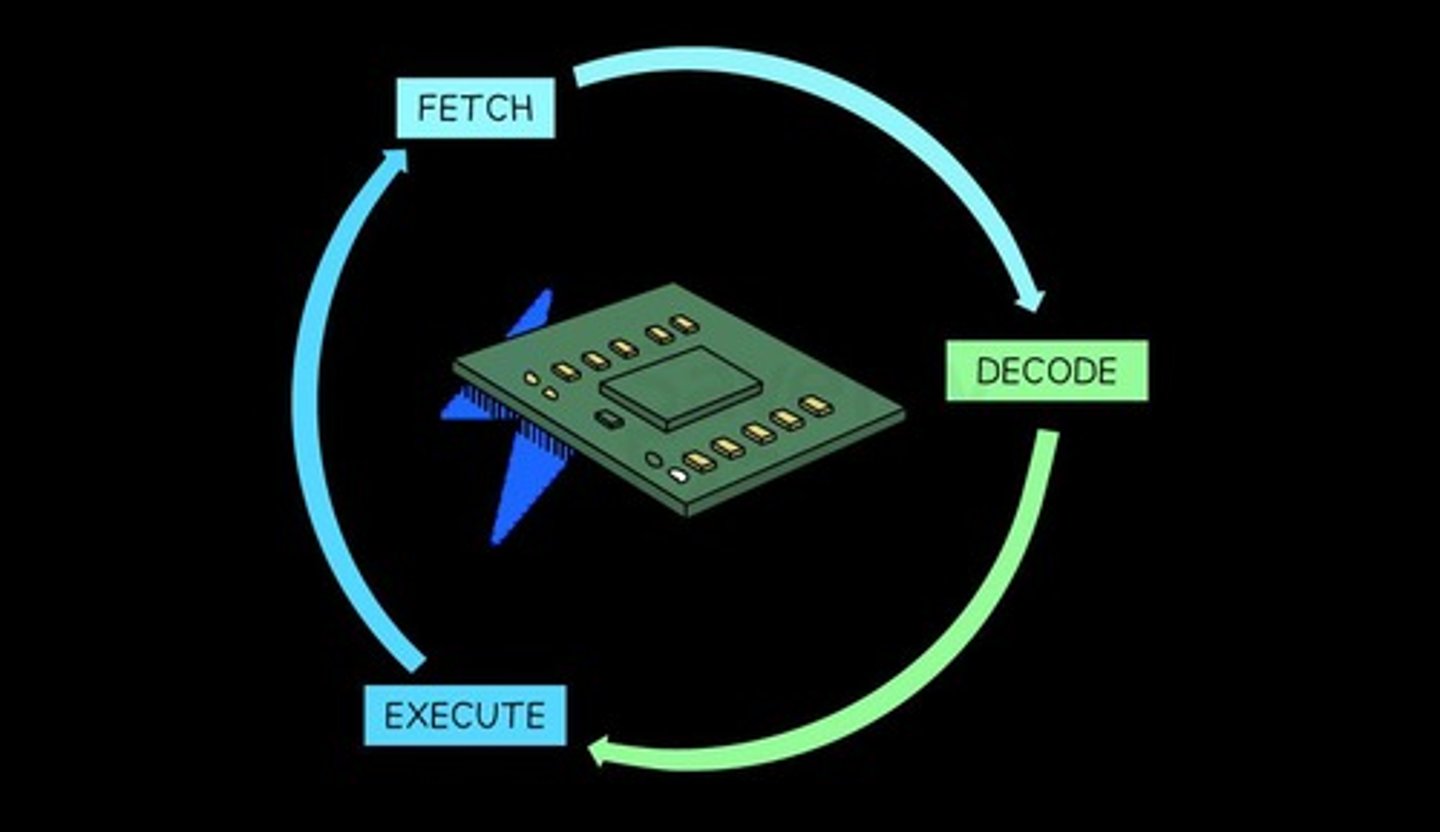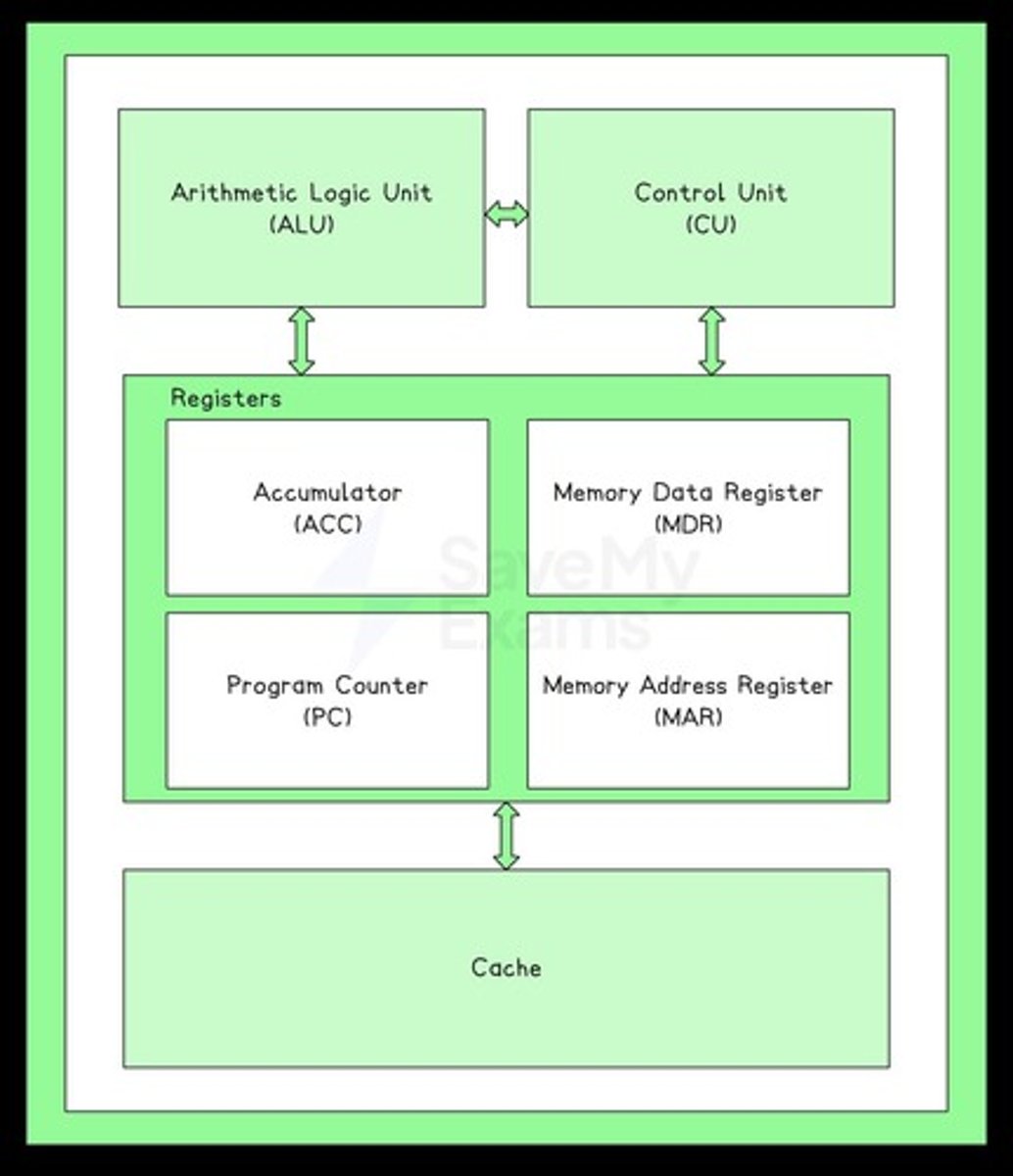CPU Architecture and Embedded Systems Overview
1/39
There's no tags or description
Looks like no tags are added yet.
Name | Mastery | Learn | Test | Matching | Spaced |
|---|
No study sessions yet.
40 Terms
CPU
The Central Processing Unit (CPU) fetches, decodes and executes instructions.
Fetch-Execute Cycle
The cycle that the CPU runs through billions of times per second to make a computer work.

Fetch Stage
During the fetch stage, the next instruction or data is fetched from the computer's memory (RAM).
Decode Stage
During the decode stage, the CPU determines what is required from the instruction.
Execute Stage
During the execute stage, the CPU carries out the fetched instruction.
CPU Components
The CPU is made up of 4 key components: Arithmetic Logic Unit (ALU), Control Unit (CU), Cache, and Registers.

Arithmetic Logic Unit (ALU)
Performs arithmetic operations and logical decisions.
Control Unit (CU)
Coordinates the activities of the CPU and manages the execution of instructions.
Cache
A small amount of high-speed memory located inside the CPU used to store frequently accessed data.
Registers
Small storage locations within the CPU used to hold temporary data and instructions.
Input Example
Clicking a button on the gamepad.
Process Example
The CPU follows a set of instructions to carry out the task.
Output Example
The player moving on screen.
Instruction Fetching
An instruction is fetched from memory.
Instruction Decoding
The instruction is decoded.
Instruction Execution
The decoded instruction is executed.
Instruction Transfer
The instruction is transferred to the MDR.
Fetch-Execute Cycle Repetition
The cycle repeats billions of times per second.
Von Neumann Architecture
The Von Neumann Architecture is a design of the CPU which was proposed by Mathematician John Von Neumann in the 1940s, which most general-purpose computers are built upon.
Program Counter (PC)
Holds the memory address of the next instructions to be executed.
Memory Address Register (MAR)
Holds the memory address of where data or instructions are to be fetched from.
Memory Data Register (MDR)
Stores the data or instruction which has been fetched from memory.
Accumulator (ACC)
Stores the results of any calculations that have taken place in the Arithmetic Logic Unit (ALU).
Clock Speed
One of the common characteristics of the CPU that impacts performance.
Cache Size
One of the common characteristics of the CPU that impacts performance.
Number of Cores
One of the common characteristics of the CPU that impacts performance.
Hertz (Hz)
A unit of frequency that measures cycles per second.
Gigahertz (GHz)
A unit of frequency equal to one billion hertz.
3.5GHz
A clock speed that can perform up to 3.5 billion instructions per second.
Read/write speed
Cache has a significantly faster read/write speed than RAM, making it quicker to retrieve instructions.
Core
A core works like it is its own CPU, capable of fetching, decoding, and executing instructions.
Multi-core processors
Processors that have multiple separate processing units that can work simultaneously.
Dual-core processor
A processor with 2 processing units, each with their own Control Unit (CU), Arithmetic Logic Unit (ALU), Accumulator (ACC), and Registers.
Quad-core CPU
A CPU with 4 cores, which can perform up to 12 billion instructions per second at a clock speed of 3GHz.
FDE cycle
The cycle in which the CPU fetches, decodes, and executes instructions.
Embedded system
A computer system with a single function, inside a larger mechanical unit.
Examples of embedded systems
Heating thermostats, hospital equipment, washing machines, dishwashers, coffee machines, satellite navigation systems, factory equipment, traffic lights.
Properties of embedded systems
They are small in size, use less power than general-purpose computers, and have a lower cost.
General-purpose computer
A computer designed to perform a wide range of tasks, unlike embedded systems which have a single function.
Justification for embedded systems
A washing machine and car engine management system are not general-purpose computers and have a single purpose housed inside a larger mechanical unit.